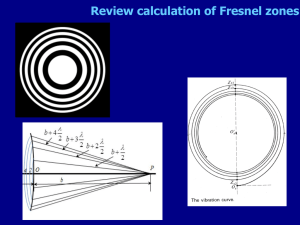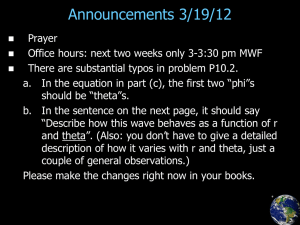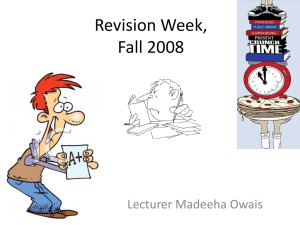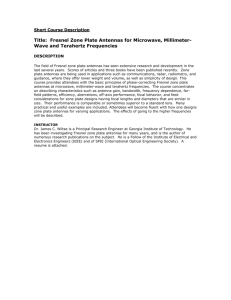Fresnel zones for ground-based antennas
advertisement
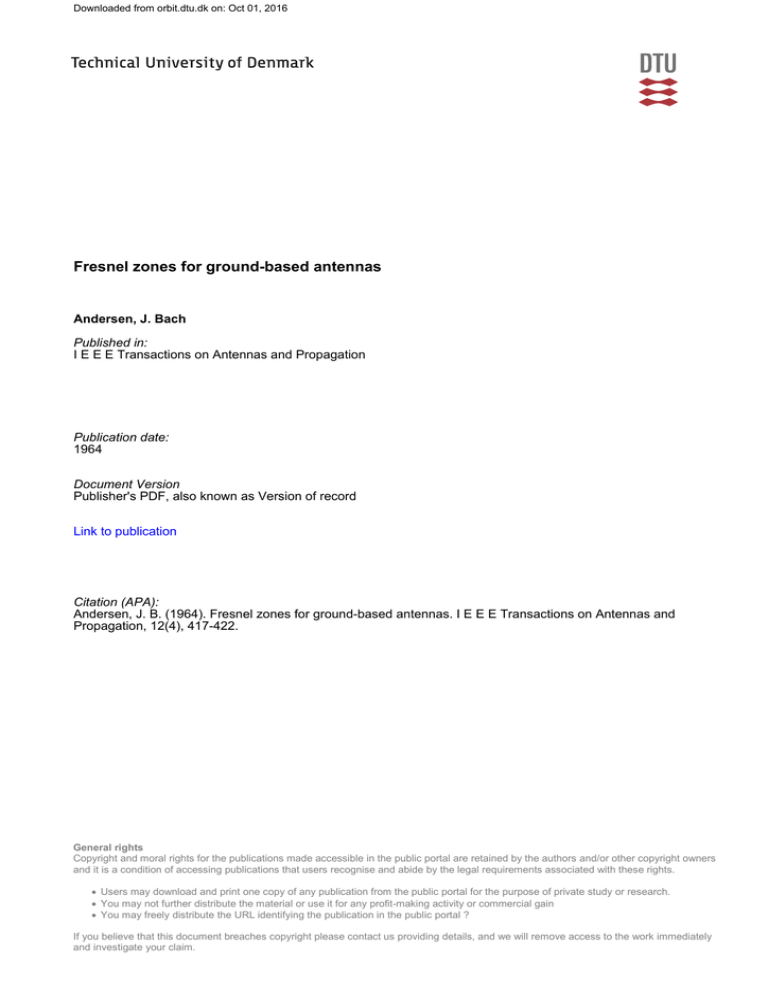
Downloaded from orbit.dtu.dk on: Oct 01, 2016
Fresnel zones for ground-based antennas
Andersen, J. Bach
Published in:
I E E E Transactions on Antennas and Propagation
Publication date:
1964
Document Version
Publisher's PDF, also known as Version of record
Link to publication
Citation (APA):
Andersen, J. B. (1964). Fresnel zones for ground-based antennas. I E E E Transactions on Antennas and
Propagation, 12(4), 417-422.
General rights
Copyright and moral rights for the publications made accessible in the public portal are retained by the authors and/or other copyright owners
and it is a condition of accessing publications that users recognise and abide by the legal requirements associated with these rights.
• Users may download and print one copy of any publication from the public portal for the purpose of private study or research.
• You may not further distribute the material or use it for any profit-making activity or commercial gain
• You may freely distribute the URL identifying the publication in the public portal ?
If you believe that this document breaches copyright please contact us providing details, and we will remove access to the work immediately
and investigate your claim.
41‘7
1964
[21] T. T. Taylor, ”Design of circular apertures for narrowbeam
widthand low sidelobes,” I R E TRAKS. OK ASTEXAS AND
PROPAGATION,
vol. AP-8, pp. 17-22; January, 1960.
[22] R. C. Hansen, “Table of Taylor distributions for circular aperON ANTESSASASD PROPAGATION,
ture antennas,” IRE TRAKS.
vol. 4P-8, pp. 23-26; January, 1960.
[23] \V. H. \.‘on Aulock, “Properties of phased arrays,” Plloc. IRE,
vol. 40, pp. 1715-1727; October, 1960.
[24] XI. I. Skolnik, “A method of modeling array antennas,” IRE
TRAKS.
OK ASTEKSASAND PROPAGATIOS,
vol. AP-11, pp. 9798; January, 1963.
[25] R. F. Packard, J. D. ,pdgers and J. iV. Sherman, “,an .Array
ModelingTechnique,presented
athe
1963 SpringURSI
Meeting, Commission 6, \\:ashington, D. C.; April 29;kIay 2.
_1962
_
\{:. Sherman,Dynamic
[16] R. E. \ViIley, “Space tapering of linear and planar arrays,”I R E [26] M. I. Skolnik,G.NemhauserandJ.
to unequally
spaced
arrays,”
IEEE
programming
applied
TRAKS.
ON ANTEXSAS
AND PROPAGATIOS,
vol. 4P-10, ..
pp. 369TRAKS.
ON ASTENKAS
AND PROPAGATION,
col. AP-12, pp. 35-43;
377; July, 1962.
January, 1964.
1171 X. Ishimaru, “Theory of unequally spaced arrays,” I R E TRANS.
[27] R. J.Spellmire,“Tables
of Taylor-4pertureDistributions,’’
ON .ASTEK’?AS A S D PROPAGATION,
VOl.
AP-10,pp.
691-702;
Hughes -Aircraft Co., Culver City, Calif., Tech. Memo. No. 581;
November, 1:62.
October, 1958.
[18] J. L. ,Allen, BeamShapingby Omission of Elements(‘Space
[28] Ll:. B. Davenport, Jr. and \V. L. Root:, “An Introduction to the
Tapermg‘orDensityTapering’)’’in”PhasedArrayRadar
Theory of Random Signals and Xoise, McGraw-Hill Book Co.,
Studies,“ hl I T Lincoln Laboratory,Lexington, Mass., Tech.
Inc., K e w York, N. Y . ;1958.
Rept. No. 236, pp. 299-305; November, 1961.
[19] S. J. Rabinonitz and R. F. Kolar, “Statistical Design of. Space [29] 1‘. T. Lo, “.A,,probabilistic approach to the design of large anos ANTENNAS
AND PROPAGATIOS,
tenna arrays. I E E E TRANS.
Tapered Arrays,” presented at the 12th Annual Symposium on
vol. aP-11; pp. 95-96; January, 1963.
US.AF AntennaResearchandDevelopmentProgram,
Uni[30] S. Ramo and J. R. Ivhinnery, “Fields and \Yax-es in Modern
versity of IllinoF, Urbana; October 16-19, 1962.
Radio,” John \Viley & Sons, S e w York, X. Y., 2nd Edition,
[20] J.R. Cogdell, Analysis of RandomArrays,” hI.1.T.Lincoln
Art. 1.11; 1953.
Laboratory, Lexington, Mass., informal memo.; .August, 1961.
M. G. Andreason,“Lineararrayswithvariableinterelement
ON ANTESSASASD PROPAGATIOK,
vol.
spacings,” I R E TR~SS.
AP-10, pp. 137-143; March, 1962.
F. C. Ogg, “Steerable array radars,” IRETRANS.
ON MILITARY
vol. 3lIL-5, pp. 8Ck94; April, 2961.
ELECTROSICS,
J. H. Best, “Space Tapered Antenna Arrays, presented
at the
IL NationalConvention,
\Yashington,
5thMil-E-ConPGkI
D. C.; June 26-28, 1961.
A. L. hlaffett, “.Array factors with nonuniform spacing parameAND PROPAGATION,
vol. -AP-10,
ter.? I R E Truss. O S ASTEKKAS
pp. 131-136; March, 1962.
[15] 1’. T. Lo, “-4 spacingweightedantennaarray,”IREISTERNATIONAL COSVESTIOKRECORD,vol. 10, pt. 1, pp. 191-195;
Fresnel Zones for Ground-Based Antennas
J. BACH ANDERSEN
Summary-The ordinary Fresnel zone concept is modiedto include the influence of finite ground conductivity. This is important
for ground-based antennas because the influence on the radiation
pattern of irregularities near theantenna is determined by the
amplitude and phase of the groundwave. A new definition of Fresnel
zones which takes into account the phaseshift of groundwave propagation is given and it is shown that these new zones are zones of
greatest influence, at least when discontinuities of the electrical
parameters of the ground are considered. Numerical results for the
fist Fresnel zone are given, and it is shown that the zone is much
an infiniteconductivity,
smallerforafiniteconductivitythanfor
especially for s m d angles of elevation.
w
INTRODUCTION
HEK ESTIMATING the influence of the surroundings on the radiation pattern
of a given
antenna often only very approximate methods
are used. T h e ground is mostly considered to be homogeneouswith a constant conductivity, and if possible
inhomogeneities are outside the first Fresnel zone, they
are considered t o b e negligible.
It has beenquestioned’s2 whether the Fresnel zone
conceptreally is applicablefor U H F a n d microwave
antennas because the cancelling of thecontributions
from the various zoneswould notbeeffectivewhen
theamplitude of the field variesmarkedlyoverthe
zones. This would be the case especially when the angle
of elevation is small because the resulting
ellipse is then
very long and very narrow.
The Fresnel zone concept is also important for vertical HF and VHF antennas, inwhichcase the ellipse
surrounds the antenna, the ground-based antenna being
situated in one of the foci. Also in this case inhomogeneities are neglected when they are outside the first
Fresnel zone, the Fresnel zones being computed under
the assumption that the groundis perfectly conducting.
I t is evidentthat if, in this latter case
also, the Fresnel
zones should be a measure of zones of greatest influence, the finite conductivity
of the ground should be
taken into account in some way. This is seen by the
fact that the groundwave,
which is generally attenuated
t o a great extent, excites the disturbance field from a n y
Manuscript received July 15, 1963; revised January 13, 1964. The
research reported in this document has been sponsored by the ElectronicsResearchDirectorate, Air ForceCambridgeResearchCenter
D. E. Kerr,“Propagation of ShortRadio \Vaves,” McGraa-Hill
of the Air Research and Development Command, USAF, through its
Book Co., Inc., New York, N. Y.,p. 417; 1951.
P. Beckman,
“On
the
problem of the reflection of radio
waves
European Office under
Contract
AF
61(052)-503.
The author is with the Laboratory of Electromagnetic Theory, from rough surfaces,”
Slaboprovdy Obrer (in Czech.), vol. 14, pp. 302the Technical University of Denmark, Copenhagen, Denmark.
309; 1953.
Authorized licensed use limited to: Danmarks Tekniske Informationscenter. Downloaded on September 25, 2009 at 09:12 from IEEE Xplore. Restrictions apply.
418
ON ANTENNAS
PROPAGATION
AhD
TRANSACTIOlYS
IEEE
July
obstacle or discontinuity in the vicinityof the antenna.
I t is the purpose of this paper to modify the Fresnel
zone concept in such a way that the dependenceon the
ground conductivity is taken into account.
THEORETICAL
DEVELOPMENT
Theboundary of a usualFresnelzonearounda
ground-based source A (Fig. 1) is defined as the locus of
D on the plane such that
AD+DB-AB=v->
x
Fig. 1-Point-source A on plane surface, D locus of boundary
of Fresnel zone, B point of reception, 1c. angle of elevation.
~ = 1 , 2 , 3 , * * * (1)
2
or
& ( A D ) - Qo(AH)
=
(2)
Y-T
where X is the wavelength, &(l) = ko.1 is the phase shift
in propagation over a length 1, and ko is the free space
wavenumber.
T h e modified Fresnelzones are now definedin the
following way:
The boundary of a modified Fresnel zone is the locus
of D on the plane such that
$bl(AD) - Q o ( A H )
=
Y‘T,
7J
= 1,
2,3,. * .
(3)
Fig. 2-Dipole on inhomogeneous ground.
where & ( A D ) is the phase shift in groundwave propagation from A t o D and & ( A H ) is the phase shiftin spacewave propagation from -4 t o H .
homogeneousground. The surface of integration S is
When the ground is perfectly conducting, (3) reduces over Medium 2. The constant in (4) is proportional t o
to (2), and the modified Fresnel zones are equal to the the difference in surface impedance between the various
usual Fresnel zones.
sections of ground.
I t is not evident from a physical viewpoint that this
Eq. (4) is useful only when the integrand can be apdefinition fulfills the needs mentioned in the Introduc- proximated in some manner; it has been shown prevition,namely t h a t the zonesshouldbe
a measure of ously that a very good approximation is obtained when
greatest influence. The only way t o provethis is to H B t ‘ is replaced by H B ~the
, field from B over a homostudy the solution t o a problem where a discontinuity
geneous ground. In approximating in this manner, reor inhomogeneity is introduced close to the antenna;
flections from the boundaryline are neglected, but these
the model chosen here is a ground which is flat and con- reflections are known t o be very small when the angle
of
sists of two sections of different electrical properties.
elevation $ is small.
Inpreviouspapers3.theradiationpatternoveran
For an arbitrary boundaryline, the integration could
inhomogeneous ground has been expressed as a surface only be done numerically but here we approximate the
integral in the following way:
boundarr line by its tangent at the point where a line
in the direction of propagation intersects the boundary.
The surface integral is then converted toa line integral
by means of the stationary phase method and the following results (for details see Andersen3- 4, :
A’ is the radiation pattern over the inhomogeneous
ground, A is the radiation pattern over a homogeneous
ground consisting of Medium 1 (see Fig. 2). i Y ~ is
t the
tangential, magnetic field from a dipole a t -4 over homogeneous ground(Medium 1). H B t ‘ is thetangential,
magnetic field from a dipole a t B over the actual, in-
G ( t / c ) = G ( p ) is Sommerfeld’s attenuation function.
to =
k r o [ d / l - cos2
+ sin2 4 - cos + cos 41
J. B. Andersen,‘TheSkywaveFieldfrom
a VerticalDipole
OveranInhomogeneous,FlatEarthConsisting
of TwoMedia,”
Tech. Iiote No. 2, AF 61(052)-503; October, 1961.
J. B. Andersen, “An Extension to the Theory of a Dipole Over
No. 4, A F 61(052)-503;
an InhomogeneousGrounds,”Tech.Note
Kovember, 1962. Part of this and the first report is publishedin
E. C. Jordan, Ed., Per“Electromagnetic Theory and Antennas,”
gamon Press, Iiew York, N. Y.; 1963.
a
Authorized licensed use limited to: Danmarks Tekniske Informationscenter. Downloaded on September 25, 2009 at 09:12 from IEEE Xplore. Restrictions apply.
(6)
Aldersen: Fresnel Zones for Ground-Based Antennas
1964
where k is the wave number 2s/X, and
defined in Fig. 2 ; also
u2 =
To,
419
4 and # are
€0
1
0
where E and u refer to Medium 1. The argument 9 in
theattenuationfunctionreducestothe
well-known
numerical distance when 4 = 0.
T h e second term in (5) represents the correction to
the far-field pattern due to the presence of the second
medium.WhenMedium
1 isperfectlyconducting,
G ( p ) = 1 and the integral in
(5) reduces t o a Fresnel
integral with argument to. A fixed to implies a constant
Fig. 3-Ordinary Fresnel zone is an ellipse when Medium 1
is infinitely conducting.
correction, and t o = n determines the first Fresnel zone,
t o = 27r the second Fresnel zone, etc. For fixed to and #,
(6) is the equationfor a circle in polar coordinates ( y o , 4 ) circle in the case, when the ground is infinitely conduct(see Fig. 3 ) . T h e ellipse corresponding t o a Fresnel zone ing.
is inscribed inthe circle in such a way that the boundary
to(’) corresponds to the first Fresnel zone,
line is tangent to theellipse. The position of the dipole is
t o ( 2 ) corresponds to the second Fresnel zone, etc.
at one of the foci of the ellipse. When the boundary is
outside the first Fresnel zone, t o > n and the correction The boundary of the first Fresnel zone accordingt o (1 1)
term in (5) is small.
indicates approximately the place where the correction
One can think of the two terms in (5) as two vectors vector starts to rotate around the asymptotic value. The
whichwhen added give the resultant A’. IVhen t o in- zone will not be an ellipse.
creases, the correction vector rotates around the endInorderto
find the “ellipse”when the “circle” is
point of A with a decreasing amplitude, and when t o is known, we utilize the fact that
CD (seeFig. 3) is a
infinite, A‘ is equal to 9 . This would give a figure cortangent to the ellipse, and from simple geometry, we
responding to the well-known Cornu spiral for Fresnel
derivethatthedistancetothepoint
of tangencyis
integrals when the conductivity is infinite.
equal to
Here we define the complementary Fresnel integralas
,it
u ( t o ) = Jt: -at
d2nt
(9)
and define the endpointsof the various Fresnelzones as
the points where the tangent to the Cornu spiral
is horizontal
and the angle 0 is given b y
The procedure for finding the modified Fresnel zones
can now be expressed in the following way:
where Im [ C F ( t o ) ]denotes the imaginary partof CF(to).
This leads to
fo =
7,2 7 ,
.
(origin not included),
*
which is in agreement with ordinary Fresnel
zone theory.
I t is now a natural extension of the Fresnel zone concept to define the various Fresnel zones for an arbitrary
ground conductivity by
or
tan ( t o )
= -
tan [arg G(po)]
1) T h e given data are 1 2 ~ ~ arg
1 ,
( a ? ) and $.
2) # is made to run from 0” t o 180”.
3) c is found from (8) for each #.
4) yo(+) is found from (11) for each 4.
5) A numericaldifferentiation of y O ( 4 ) yields x and
0 by means of (13) and (14) and the Fresnel zone
may be plotted.
These computations can easily be made by means of
an electronic computer when a procedure for Sommerfeld’s attenuation function exists. Such a procedure has
been given by Christiansen5 and is described
in a report,
where i t is used for finding parametric curves for radiation fields from an antenna near a coastline.
(12)
5 S. Christiansen and J. B. A\ndersen, ‘ParametricCurves
for
instead of (10). The zeros of (l’),t0(l), t o ( ? ) etc.
,
deterRadiation from a Vertical Dipole near a Coastline,” Tech. Kote No.
mine curves in the( T O , +)-plane which correspond to the 6, AF 61(052)-503; 1963.
Authorized licensed use limited to: Danmarks Tekniske Informationscenter. Downloaded on September 25, 2009 at 09:12 from IEEE Xplore. Restrictions apply.
IEEE TRANSACTIOlVS 0:V ANTEXAVAS A X D PROPAGATION
420
JdY
Finally, i t should be mentioned that the present extension of the Fresnel zone concept could just as well
be based on the usual Kirchhoff method of integration
over a homogeneous surface.6
If u is a z-component of a Hertzian vector, we could
write
@)
=
uo(@
+;J’S [T an- ,a( 3 1 a.
du
an
This formulation is similar to the formulation in (4),
which was based on the compensation theorem.
If zt in the integral is approximated by
eQp
,uz-o
= g(p)
P
where p is the distance fromA , and we neglect the slow
variation of g ( r , y) compared to the exponential function, then the usual Fresnel
zones are determined by
the stationary phase of the integral.
When the dipoles are sufficiently elevated, g ( p ) is a
constant, but when the dipole a t A is ground-based,
g(p) is given b y Sommerfeld’s attenuationfunction
G ( p ) ,and if this is included in the integral and thezones
over which the phase is stationary are found, then (11)
is derived again.
Thus it seems t h a t i t is a n unnecessary complication
to introduce asecond medium and base theextension of
the Fresnel zone concept on the influence of this second
medium. However, this is done in order
t o verify the
applicability of the Fresnelzoneprinciple
in a case
where the actual ground is inhomogeneous.
I t is not difficult t o show t h a t (12) is in agreement
with (3), and the modified (as well astheordinary)
Fresnel zones are therefore zones of greatest influence.
Fig. 4-U=
-tan(argG(po)} and tan(to) as a function of to
+=loo,
+=oo.
-x-
I P I =0.01,
arg(u2)= -loo.
-A-
lu21 =0.1,
arg(u2)= -70°.
-0- 1 ~ =0.01,
~ ~ 1 arg(ue)= -7OO.
FromFig. 4 i t is now easilyseenhow
the Fresnel
zones are modified by the finiteconductivity of t h e
NUMERICAL
RESULTS
ground. When 1 2 ~ ~is1 equal to zero (a= m ) , U equals
In order to determine the
Fresnel zones i t is necessary zero and the pointsof intersection are t o = n,2n, . , etc.
For finite u2 ,the first point of intersection lies between
t o solve the transcendental equation (12)
zero and n,the second between T and 2n, etc. Thus the
tan (to) = U ,
first Fresnel zone moves in around the antenna with no
where
lower theoreticallimit.Thereis
a limitationthough,
because Sommerfeld’s attenuation function is not valid
U = - tan [arg G(po)].
unless zt21 <0.2.
Curves of arg G(p0) as a function of the numerical
An interesting,special casewhich is not shown on
distance can be found in the literature. The function U Fig. 4 is the case of a lossless, dielectric ground. Then
is shown in Fig.4 together withtan(t0) for various values the argument of G@o) neverreaches ~ / 2 and
,
U deof u 2 and arg ( u 2 ) . The intersection between the two creases to minus infinityfor to--) 30. If u 2 1 is great
curves determined the various Fresnel zones according enough, the points of intersection are ~ / 2 ,3a/2, . . ,
t o (12). The points marked (1) give the firstFresnel
;.e., n/2 less than the value for a perfect conductor.
zone, (2) the second Fresnel zone, etc. T h e general beA computerprogram whichgives thefirstFresnel
haviour of U(to) is as follows: U is negative until the
zonefor arbitrary values of the parameters has been
phase of G is n/2, where i t goes from minus infinity t o written in Algol. Because there is only one root
of (12) in
plusinfinity,after
which it decreases t o a constant the interval 0 < t o S r , a regula falsi method could be
positive value for to-+ =.
used to determine the roots.
For each value of 4, .zt2 and arg ( u 2 ) , kro was found
6 G. Boudouris, “Propagation Tropospherique,” Centre de Docufor + = ( l o , loo, . , 180’. Thesenineteenvalueswere
mentation Universitaire, Paris, France; 1957.
I I
I
I I
I
-
I
I
Authorized licensed use limited to: Danmarks Tekniske Informationscenter. Downloaded on September 25, 2009 at 09:12 from IEEE Xplore. Restrictions apply.
-
42 1
--Indewen.: Fresnel Zones for Ground-Based Antennas
Y =5'
-
/
.4 0
20
-
02
0
argu'=-70'
Fig. 5-First
argu'=-fO'
Fig. 6-First
Fresnel zone for \1. = 5'.
k.r.
Fig. 7-First
Fresnel zone Tor
Fresnel zone for $= 10'.
4
$==no.
Authorized licensed use limited to: Danmarks Tekniske Informationscenter. Downloaded on September 25, 2009 at 09:12 from IEEE Xplore. Restrictions apply.
IEEE
TRANSACTIONS
422
0:Y A N T E N N A S AND PR.OPAGATTON
CONCLUSION
then used in a numericaldifferentiationprocedure
to
find x and 6 according t o (13) and (14). Some numerical
An evaluation of the influence of finite ground conresults are displayedin Figs. 5-7 for $ = 5", 10" and lo", ductivity on Fresnel zones has been given. I t is shown
arg (u2)= - 10" (a lossy dielectric), and arg ( u ? ) = - 70' t h a t all the Fresnel zones move in around the antenna
(a good conductor), and u21= 0 , 0.01, 0.05, 0.1, 0.2.
when the ground is lossy, and the first Fresnel zone,
I t is seen that in general the size and form of the zones which is of primary interest, is in general much smaller
are different from the usual ones u2 = 0). The change thantheonecomputedfor
a perfectlyconducting
is greatest in the direction of propagation (4 = 0) and is ground. The higher-order Fresnel zones are modified t o
very small in
the backward direction (+ = 180"). For a smaller extent.
small angles of elevation ($= j " ) , the length of the zone
T h e numerical results for the first Fresnel zone show
is only about $ of the length for a perfect conductor,
that the mostradical change takes place when the angle
when arg ( u 2 ) = -70". Normally, the change is greater of elevation is small and when the numerical value
of
for a conductor than for a dielectric for the same u21. the complex dielectric constant is small. For equal nuAnexamplewhichshows
theapplicability of the merical values of the complex dielectric constant, the
Fresnel zone concept is shown in Fig. 8. The ordinate change of the first Fresnel zone compared t o a perfect
is the radiation pattern amplitude (in db relative to
a conductor is greatest when the phase of the dielectric
perfectlyconductingground)from
a verticaldipole
constant corresponds t o a good conductor.
which is placed on a lossy ground at a distance Y O from
The resultsgiven can be applied wheni t is of interest
a perfectly conducting medium. T h e projection of the t o know what part of the antenna surroundings infludirection of propagation is normal to the boundary be- ence the radiation pattern. The antenna is supposed t o
tween the two media. The frequency is 10 Mc, (r=
be a verticalground-basedantenna,andthepresent
mho/m and ~ , = 7 for the medium around the dipole,
Fresnel zone concept is
usefulfor antennas operating
and $J= 5" and 10". I t is evident from the curves that thein the H F and VHF range.
Fresnelzonedefined in the text (a) is a much better
I t must be emphasized that the present extension of
measure of the limit of greatest influence than the usual the Fresnel zone concept is based on a flat ground with
Fresnel zone (b). IVhen kro is greater than krFr(a), A'( electrical discontinuities, i t is not directly applicable to
only deviates about 1 d b from its asymptotic value.
irregular terrain unless the irregularities are such that
I
I
(I
I
1
.I3
-i'
~
Irn
100
- .
~
x.:
~
.
a
-~
Y)
a0
M.:
I
.
83-
~
m
'm,
'r.
-
Fig. 8-Radiation
pattern amplitude for a vertical dipole placed on
a lossy ground ( e r = 7 , u=10-2 mho/m, f = l O %IC) in a distance
y o from a perfectly conducting medium.
(a) corresponds to end
of first Fresnel zone as given in Figs. 5 and 6 . (b) corresponds to
the usual Fresnel zones.
a n effective surface impedance can be ascribed to the
surface.Furthermore,onlythephase
of thegroundwave enters in this calculation because the phase determines the distance from the antenna to the point, outside of which the contributions from the various zones
tend to cancel due to phase relationships.When t h e
boundary line between the hvo media is outside the first
Fresnel zone, the radiation pattern deviates only little
from the radiation pattern over homogeneous ground.
The magnitude of the groundwave is also important,
because i t is responsible for the amplitude of the deviations. Thus we can conclude t h a t a finite conductivity
diminishes the influence of thesurroundings in two
ways: the important area of reflection around the antenna gets smalIer, and the magnitude of any disturbance fields gets smaller than for a perfectly conducting
ground. Only the former has been considered here in a
quantitative manner.
Authorized licensed use limited to: Danmarks Tekniske Informationscenter. Downloaded on September 25, 2009 at 09:12 from IEEE Xplore. Restrictions apply.
